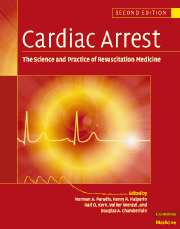Book contents
- Frontmatter
- Contents
- List of contributors
- Foreword
- Preface
- Part I Introduction
- Part II Basic science
- 3 Global cellular ischemia/reperfusion during cardiac arrest: critical stress responses and the postresuscitation syndrome
- 4 Genetics, genomics and proteomics in sudden cardiac death
- 5 Intracellular signaling during myocardial ischemia
- 6 Electrophysiology of ventricular fibrillation and defibrillation
- 7 The neuroendocrine response to global ischemia and reperfusion
- 8 Inflammatory and Immunologic responses to ischemia and reperfusion
- 9 Methodology of laboratory resuscitation research
- 10 The methodology of clinical resuscitation research
- 11 The special problem of consent for resuscitation research
- Part III The pathophysiology of global ischemia and reperfusion
- Part IV Therapy of sudden death
- Part V Postresuscitation disease and its care
- Part VI Special resuscitation circumstances
- Part VII Special issues in resuscitation
- Index
4 - Genetics, genomics and proteomics in sudden cardiac death
from Part II - Basic science
Published online by Cambridge University Press: 06 January 2010
- Frontmatter
- Contents
- List of contributors
- Foreword
- Preface
- Part I Introduction
- Part II Basic science
- 3 Global cellular ischemia/reperfusion during cardiac arrest: critical stress responses and the postresuscitation syndrome
- 4 Genetics, genomics and proteomics in sudden cardiac death
- 5 Intracellular signaling during myocardial ischemia
- 6 Electrophysiology of ventricular fibrillation and defibrillation
- 7 The neuroendocrine response to global ischemia and reperfusion
- 8 Inflammatory and Immunologic responses to ischemia and reperfusion
- 9 Methodology of laboratory resuscitation research
- 10 The methodology of clinical resuscitation research
- 11 The special problem of consent for resuscitation research
- Part III The pathophysiology of global ischemia and reperfusion
- Part IV Therapy of sudden death
- Part V Postresuscitation disease and its care
- Part VI Special resuscitation circumstances
- Part VII Special issues in resuscitation
- Index
Summary
Introduction
Sudden cardiac death (SCD) is an enigma: despite an overall decrease in cardiac mortality, SCD rates appear to be rising along with the concomitant increase in prevalence of coronary disease and heart failure. Even with decades of research, the underlying cellular mechanisms and stimulus/triggers are not well understood. This chapter addresses the application of large scale “omic” strategies to this critical clinical problem. First, is a discussion of the steps currently underway using genetic strategies to characterize several inherited arrhythmogenic diseases. The final two sections focus on two newer strategies, the technologies of genomics and proteomics.
Genetics, genomics and proteomics are complementary technologies. Figure 4.1 shows the flow from genes to proteins and emphasizes the increasing complexity at each step. Genetics strategies concentrate on identifying and characterizing a small number of candidate genes, informed by our understanding of the relevant biology, and are largely focused on analyzing sequence variants.Genomics looks more globally, with new approaches using unbiased whole-genome scans to examine both sequence variants and other genomic alterations, such as copy number polymorphism. Analysis of expressed genes, mRNA, is performed using the technologies of transcriptomics. Finally, the expressed proteins are studied using proteomics. This includes potential mutations (seen as amino acid changes) as well as post-translational modification (such as glycosylation or phosphorylation). It is only through the combined application of these technologies that we will be able to elucidate the underlying mechanisms of SCD, with the ultimate goal of both predicting individual risk and improving therapeutic intervention.
- Type
- Chapter
- Information
- Cardiac ArrestThe Science and Practice of Resuscitation Medicine, pp. 70 - 89Publisher: Cambridge University PressPrint publication year: 2007



